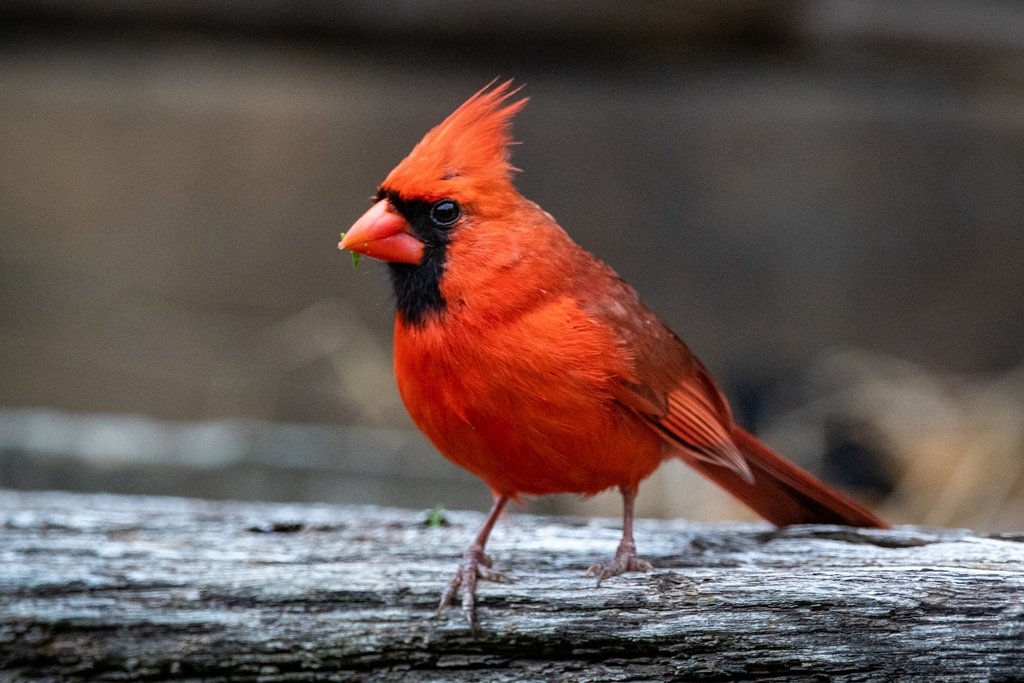Embark on a journey of discovery with “50 Northern Cardinal Facts.” Dive into the world of these iconic birds known for their vibrant plumage and enchanting melodies. Explore their behaviors, habitats, and the unique features that make them beloved symbols of beauty in nature.
Table of Contents
Key Facts About Northern Cardinals
| Category | Northern Cardinal Key Facts |
|---|---|
| Colors | Male: Vibrant red plumage with black mask around bill. Female: Grayish-brown with reddish tinges on wings, tail, and crest. |
| Color Variations | Regional variations in color intensity due to diet and genetics. |
| Characteristics | Distinctive crest, stout orange-red bill, strong legs for perching and hopping. |
| Length | 21-23 cm (8.3-9 inches) |
| Weight | 33-48 grams (1.2-1.7 ounces) |
| Wingspan | 25-31 cm (10-12 inches) |
| Range | North America, from southern Canada through the United States into Mexico. |
| Habitat | Woodlands, gardens, shrubby areas, and urban parks. |
| Migration | Non-migratory; some individuals may make short movements in response to food availability and weather. |
| Diet | Primarily seeds (especially sunflower seeds), insects, fruits, and berries. |
| Nesting | Cup-shaped nests in dense shrubs or trees, often constructed by females. |
| Breeding | Monogamous pairs that defend territories and share parental duties. |
| Life Span | Average lifespan in the wild is 3-5 years; can reach up to 15 years. |
| Social Behavior | Territorial during breeding season; form loose flocks outside breeding periods. |
| Predators | Vulnerable to predation by cats, hawks, and snakes. |
| Voice and Song | Loud, clear whistling songs; males and females both vocalize. |
| Conservation | Not globally threatened; habitat loss and collisions with windows are significant risks. |
| Migration Myth | Often mistakenly believed to migrate south for winter due to bright colors. |
| State Bird | Designated state bird of seven U.S. states. |
| Symbolism | Represents vitality, joy, and hope in various cultures. |

50 Fun Facts About Northern Cardinals
Introduction to the Northern Cardinal: The Northern Cardinal (Cardinalis cardinalis) is a striking bird native to North and Central America, known for its vibrant red plumage and melodious song.
Range and Habitat: Cardinals are widespread across North America, from southern Canada through the United States and into Mexico. They thrive in various habitats including woodlands, gardens, and urban areas.
Physical Description: Adult males are recognized by their brilliant red plumage, while females are primarily brown with red accents. Both sexes sport a distinctive crest and a stout, orange-red bill.
Diet: Cardinals are primarily seed-eaters, favoring sunflower seeds and other types of seeds. They also consume insects, fruits, and berries, particularly during breeding season.
Voice and Song: Male cardinals are known for their loud, clear whistling songs, often repeating phrases like “cheer, cheer, cheer” or “purty, purty, purty.” Females sing as well, typically in response to male calls.
Breeding Behavior: Cardinals are monogamous during the breeding season. They form pair bonds that often last for years, and both parents contribute to raising their young.
Nesting Habits: Females build cup-shaped nests using twigs, bark, and grasses, usually placed in dense shrubs or trees. They typically lay 3-4 eggs per clutch, which are pale greenish-white with brown markings.
Incubation and Fledging: The female incubates the eggs for about 11-13 days, and both parents feed the nestlings. Young cardinals fledge about 7-13 days after hatching.
Behavioral Traits: Cardinals are not migratory birds, though they may move short distances in response to food availability or climate changes.
Predators and Threats: They face threats from predators such as cats, hawks, and snakes. Habitat loss and collisions with man-made structures also pose risks.
Adaptations: Cardinals have strong bills adapted for cracking seeds and are adept at foraging in dense vegetation for insects and fruits.
Population and Conservation: While not currently considered threatened, monitoring populations and conserving habitats are crucial for their continued well-being.
Symbolism and Cultural Significance: Cardinals hold symbolic value in various cultures, often representing vitality, joy, and hope.
State Bird: The Northern Cardinal is the state bird of seven U.S. states, including Illinois, Indiana, Kentucky, North Carolina, Ohio, Virginia, and West Virginia.
Color Variation: In some areas, cardinals may appear more orange or yellow due to diet differences affecting their feather pigmentation.
Social Behavior: Cardinals are generally territorial during the breeding season, with males aggressively defending their territories against intruders.
Feeding Preferences: Apart from seeds and fruits, cardinals consume insects such as beetles, grasshoppers, and spiders, providing ecological benefits by controlling pest populations.
Migration Patterns: While not migratory, some individuals may move to lower elevations during harsh winters, seeking milder climates and reliable food sources.
Vocalization Studies: Research indicates that cardinals have distinct regional dialects, with variations in their songs and calls across different populations.
Courtship Displays: Males engage in courtship displays that include singing, hopping, and offering food to females as part of the pair-bonding process.
Egg and Nest Parasitism: Cowbirds occasionally parasitize cardinal nests by laying their eggs, but cardinals may abandon the nest if they detect foreign eggs.
Urban Adaptability: Cardinals readily adapt to urban environments, nesting in parks, gardens, and suburban areas where suitable vegetation and food sources are available.
Migration Myths: Despite their bright coloration, cardinals do not migrate based on the misconception that bright birds migrate and dull birds do not.
Temperature Regulation: Cardinals fluff their feathers in cold weather to create insulating air pockets, helping them maintain body heat during winter.
Nestling Development: Nestlings develop rapidly, growing from hatchlings to fledglings within a few weeks under the care of attentive parents.

Sexual Dimorphism: The bright red plumage of male cardinals serves as a visual signal to attract mates and defend territories, while female coloration provides camouflage.
Urban Birdwatching: Birdwatchers in urban areas often spot cardinals due to their conspicuous color and vocalizations, making them popular subjects for backyard birding.
Pollination Role: Cardinals contribute to plant pollination by consuming fruits and dispersing seeds across their range, influencing forest regeneration dynamics.
Environmental Adaptation: Cardinals thrive in diverse habitats, ranging from subtropical forests to temperate woodlands, demonstrating adaptability to various ecological conditions.
Molt Patterns: Cardinals undergo molting processes, shedding and regrowing feathers annually to maintain plumage quality and insulation efficiency.
Nest Defense: Both male and female cardinals defend their nests against predators and intruders, exhibiting aggressive behavior to protect their offspring.
Parental Care: Cardinal parents provide food and protection to nestlings and fledglings, demonstrating cooperative breeding behaviors during the nesting period.
Feeding Frequency: Cardinals consume multiple meals throughout the day, foraging actively to meet their dietary needs and maintain energy levels.
Juvenile Plumage: Young cardinals display duller colors than adults, gradually acquiring red plumage through molting cycles as they mature.
Spring Vocalization: Male cardinals intensify their vocalizations during the spring breeding season, establishing territories and attracting mates through song.
Resident Behavior: Cardinals remain year-round residents in their preferred habitats, establishing long-term territories for feeding, nesting, and social interactions.
Feather Pigmentation: Diet influences the intensity of red coloration in male cardinals, with carotenoid-rich foods enhancing feather pigmentation during molt.
Habitat Selection: Cardinals select nesting sites based on vegetation density, preferring shrubs and trees that provide shelter, nesting materials, and foraging opportunities.
Winter Survival: Cardinals forage for food sources in winter, including seeds, berries, and insects, adapting feeding strategies to survive cold weather conditions.
Predator Avoidance: Cardinals employ camouflage and behavioral adaptations to evade predators, utilizing dense vegetation and vigilant behaviors to minimize detection.
Migratory Patterns: Cardinals exhibit site fidelity to breeding territories, maintaining consistent locations for nesting and raising offspring during the breeding season.
Food Storage: Cardinals may cache food items such as seeds and insects, storing reserves in concealed locations for later consumption during periods of scarcity.
Urban Noise Adaptation: Cardinals adjust vocalizations and foraging behaviors in response to urban noise levels, adapting communication strategies to maintain social interactions.
Nestling Growth: Cardinal nestlings experience rapid growth rates, receiving parental care and food provisioning to support developmental milestones during the nesting period.
Temperature Regulation: Cardinals regulate body temperature by adjusting feather positioning and fluffing feathers in cold weather, conserving heat and energy reserves.
Fledgling Development: Young cardinals undergo fledgling stages, acquiring flight and foraging skills under parental supervision to enhance survival capabilities.
Sexual Selection: Female cardinals assess male plumage coloration and vocal quality during courtship displays, selecting mates based on reproductive fitness indicators.
Nestling Nutrition: Cardinal parents provide high-protein diets to nestlings, supplementing insect prey with seeds and fruits to support growth and development stages.
Mating Rituals: Cardinals engage in courtship rituals, involving vocal duets and feeding displays to reinforce pair bonds and coordinate nesting activities.
Population Dynamics: Cardinals maintain stable populations across their range, exhibiting resilience to environmental changes and habitat disturbances affecting breeding success.
Conclusion
In conclusion, the northern cardinal continues to fascinate and inspire with its stunning appearance and captivating behaviors. Through these “50 Northern Cardinal Facts,” we’ve gained a deeper appreciation for their role in our ecosystems and their enduring appeal to bird enthusiasts worldwide. Whether observed in backyards or woodlands, these birds remind us of the natural wonders waiting to be explored, encouraging us to cherish and protect the diverse wildlife that enriches our lives.



